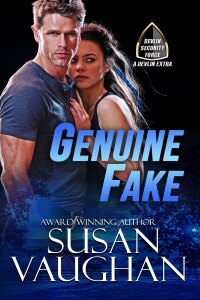Lea Wait's Blog, page 97
December 3, 2021
Weekend Update: December 4-5, 2021
 Next week at Maine Crime Writers there will be posts by Brenda Buchanan (Monday), Maggie Robinson (Tuesday), Jule Selbo (Thursday) and Joe Souza (Friday).
Next week at Maine Crime Writers there will be posts by Brenda Buchanan (Monday), Maggie Robinson (Tuesday), Jule Selbo (Thursday) and Joe Souza (Friday).
In the news department, here’s what’s happening with some of us who blog regularly at Maine Crime Writers:
Dick Cass published the sixth in the Elder Darrow jazz mystery series, Mickey’s Mayhem, on November 24. 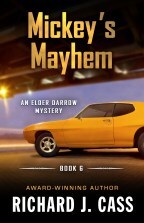 Here’s a lovely review from Mystery Scene magazine.
Here’s a lovely review from Mystery Scene magazine.
And here’s a short synopsis:
An intimate member of the Esposito family becomes the victim of murder by heroin overdose. Suspicion is cast on the gangster kingpin from Sweetie Bogan’s Sorrow, Frank Vinson, but Mickey Barksdale, Boston’s equivalent in the criminal world, might bear some responsibility, too. Mickey is running a money laundry through the local culinary institute, but his lieutenant there is up to his own crooked tricks. On the personal side, Burton mourns the loss of his relationship with Marina Antonelli, while Elder Darrow and Susan Voisine come together again, then part, maybe for good this time.
As always–signed copies through Kelly’s Books to Go. Love to hear what you think.
Susan Vaughan: A new five star review of Genuine Fake gave me something to celebrate. Reading it literally left me breathless. You’ll see why. “This story has a lot of thrills, danger, action, suspense and romance keeps you turning the pages until the very end hats off to this author looking forward to reading more books from her.”
Maine Crime Writers tree at Augusta Elks Festival of Trees: As we always say at Maine Crime Writers, books make great gifts! The Maine Crime Writers are sponsoring a tree at the Augusta Elks Festival of Trees, which takes place Dec. 6-11, at the Augusta Elks Club, 397 Civic Center Drive, Augusta. Admission is $2, and there will be more than 2o themed trees — including ours! You buy raffle tickets, then drop the tickets in the bucket in front of the trees you’d like to win. You win the tree (they’re all artificial), all the ornaments on it, and everthing under it. The Maine Crime Writers tree includes dozens of books donated by their authors, as well as some crime and mystery-related goodies. For more information, including specific hours, check out the Augusta Elks 964 Festival of Trees Facebook post.
The festival is a fundraiser for the renovation of Augusta’s historic Colonial Theater, and there’ll be plenty of fun trees to bid on besides ours. Watch the Maine Crime Writers Facebook page Sunday night or Monday for a full view of the decorated tree at the festival.

Some of the books that will be under the Maine Crime Writers tree at the Augusta Elks Festival of Trees.
An invitation to readers of this blog: Do you have news relating to Maine, Crime, or Writing? We’d love to hear from you. Just comment below to share.
And a reminder: If your library, school, or organization is looking for a speaker, we are often available to talk about the writing process, research, where we get our ideas, and other mysteries of the business. We also do programs on Zoom. Contact Kate Flora
Barefoot in the Snow, and Uphill Both Ways

These trees weren’t there when we were small, so we slide unimpeded down to the lake
Kate Flora: Recently someone posted a photo on facebook of kids with backpacks walking through the snow, which started some of us joking about how when we were kids, winter was WINTER. Yes, when we were kids, we sometimes walked home a couple miles through the snow. It wasn’t all uphill or downhill, but a combination of both, but choosing to walk meant we wouldn’t have to ride on the bus for over an hour before it was our turn to be dropped off.
We lived on a hill top, in an 1811 farmhouse. Because we were above Sennebec Pond, someone, probably our mother, dubbed it Sennebec Hill.
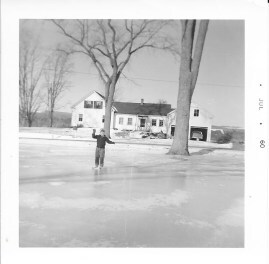
Skating on the pond across the street
There really were more serious winters back then, with snow piles big enough to build igloos, and sometimes the pond would freeze and we could skate for miles. Our mother, always anxious about her children falling through the ice or down a well, wouldn’t let us onto the pond until our father had gone down with his ax and chopped a hole in the ice to make sure it was thick enough. Then we could skate.
If you’ve never skated on a frozen pond, let me say that it is an experience. Later in the day, when the warmth of the day has expanded the ice and the cold is contracting it, there were be huge booming crashes and sudden crack lines running beneath your feet. Scary and exciting. Sometimes we could watch ice boats racing down the pond, and sometimes ice fishermen would drive their trucks right out onto the ice. An anxious child, I always worried that the insanely fast ice boats would crash and those trucks would disappear beneath the ice. I wonder now, looking back, whether my anxiety about all the bad things that could happen was a precursor to my present career. I definitely do make a lot of bad things happen.
At this season, during one of those Maine Decembers, we would be putting the finishing touches on the gifts we would be sending
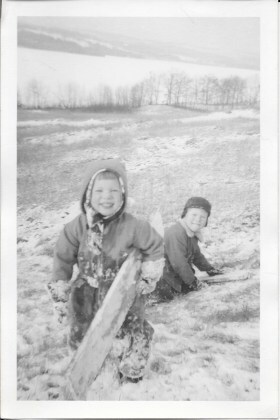
When you’re a kid, you don’t need much snow to go sledding. You don’t even need a sled.
to friends and relatives in New York and New Jersey. We didn’t have money for gifts, but we could bake and we had a hundred acres of woods. While my father scoured the woods and fields for tiny plants and made terrariums in little glass bowls, we would help bake dozens of cookies of different kinds and pack them in tins. I would go out to the woods, cut balsam branches, then chop them into tiny pieces to stuff the balsam pillows I sewed on our trusty Singer machine.
Sometimes it would rain atop the snow and there would be a fierce crust of ice. That meant we could flatted cardboard boxes into sleds and fly down the slopes to the pond. Of course, getting back up those slippery hills could be a challenge, especially if the ice was so thick we couldn’t kick holes for our feet to climb back up. There were times when our ascent was on hands and knees. Still, there was little as exciting as sliding down those hills, hoping we’d make it to the bottom while also hoping we wouldn’t run into a tree. The stream through the field beside the house was especially challenging, as it froze into a thick, slick river of ice right down into a briar patch and a swamp.
I don’t miss shoveling snow, or that long walk home, but sometime I’d again like to skate on a frozen pond or dig an igloo for the newest generation.
December 1, 2021
Holiday Books
Kaitlyn Dunnett/Kathy Lynn Emerson here, today thinking about writing books to include a particular holiday. Christmas, especially, is popular in mystery and romance novels. Some of that is due to publishers asking for Christmas-themed books. More, I think, has to do with the heightened emotions that holiday provokes. As anyone in law enforcement knows, a whole lot of people murder their nearest and dearest as a direct result of family gatherings at yuletide.
 Homicide aside, there’s plenty of fictional fodder associated with holidays. I’ve exploited that in my books several times. The first instance was in the contemporary romance novel, Relative Strangers, in which my heroine, Corrie Ballantyne, runs away from home at Christmas to avoid facing her fractured family. She spends the holiday at the Sinclair House in Waycross Springs, Maine, a venerable old hotel that just happens to be haunted. The inspiration for the book came from real life, when my husband and I decided to skip Christmas with the family one year and instead spend the holiday at the Bethel Inn, enjoying an old-fashioned Christmas with total strangers. This was not a popular decision with our family, but it was a lot of fun.
Homicide aside, there’s plenty of fictional fodder associated with holidays. I’ve exploited that in my books several times. The first instance was in the contemporary romance novel, Relative Strangers, in which my heroine, Corrie Ballantyne, runs away from home at Christmas to avoid facing her fractured family. She spends the holiday at the Sinclair House in Waycross Springs, Maine, a venerable old hotel that just happens to be haunted. The inspiration for the book came from real life, when my husband and I decided to skip Christmas with the family one year and instead spend the holiday at the Bethel Inn, enjoying an old-fashioned Christmas with total strangers. This was not a popular decision with our family, but it was a lot of fun.
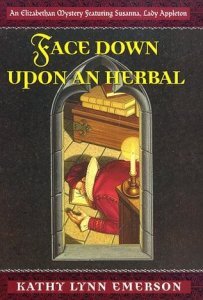 A short time later, I wrote another Christmas book, this one in my historical Face Down Mysteries series. Face Down upon an Herbal sends my amateur sleuth, Lady Appleton, to a castle in Gloucestershire for the yuletide season. That three murders take place there does not keep the residents from celebrating the holidays in true Elizabethan fashion.
A short time later, I wrote another Christmas book, this one in my historical Face Down Mysteries series. Face Down upon an Herbal sends my amateur sleuth, Lady Appleton, to a castle in Gloucestershire for the yuletide season. That three murders take place there does not keep the residents from celebrating the holidays in true Elizabethan fashion.
Another contemporary romance, That Special Smile, also has scenes at and around Christmas, and for other books (The Finder of Lost Things; Winter Tapestry; The Corpse Wore Tartan) I’ve dealt with the hazards of being snowed in. Hearth, Home, and Hope (retitled The Rapunzel Trap when it was reissued as an e-book) includes a scene on Valentine’s Day. Overkilt revolves around Thanksgiving, but it wasn’t until I started writing the Liss MacCrimmon Mysteries as Kaitlyn Dunnett that I was asked to write a book centered around a specific holiday. The second time, it was even called “untitled Christmas mystery” in my contract.
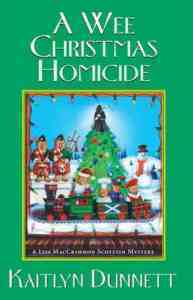 A Wee Christmas Homicide opens with Liss’s discovery that she and two other merchants in Moosetookalook, Maine have one of the last hoards of the gift everyone wants for Christmas—Tiny Teddies. Profit-mongering, mayhem, and murder ensue. I based this on the shortage of Beanie Babies one Christmas back in the 90s. They were even (gasp!) being smuggled in from Canada.
A Wee Christmas Homicide opens with Liss’s discovery that she and two other merchants in Moosetookalook, Maine have one of the last hoards of the gift everyone wants for Christmas—Tiny Teddies. Profit-mongering, mayhem, and murder ensue. I based this on the shortage of Beanie Babies one Christmas back in the 90s. They were even (gasp!) being smuggled in from Canada.
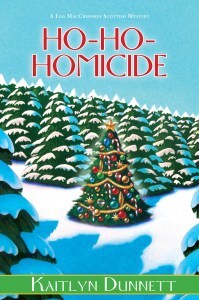 In the second Christmas book, Ho-Ho-Homicide, Liss and her husband, doing a favor for a friend, agree to spend some time on a Christmas tree farm, trying to discover what happened to its owner, who disappeared off the face of the earth some years earlier. Since my husband and I, at that time, had a Christmas tree farm of our own, I was able to bring first-hand experience to the story. We never, however, ran a body through the netter before shipping it off to New York in a load of Christmas trees. Honest.
In the second Christmas book, Ho-Ho-Homicide, Liss and her husband, doing a favor for a friend, agree to spend some time on a Christmas tree farm, trying to discover what happened to its owner, who disappeared off the face of the earth some years earlier. Since my husband and I, at that time, had a Christmas tree farm of our own, I was able to bring first-hand experience to the story. We never, however, ran a body through the netter before shipping it off to New York in a load of Christmas trees. Honest.

using the netter the right way
Do you have a favorite mystery novel set at Christmas. Please share in the comments.

Kathy Lynn Emerson/Kaitlyn Dunnett has had sixty-four books traditionally published and has self published others, including several children’s books. She won the Agatha Award and was an Anthony and Macavity finalist for best mystery nonfiction of 2008 for How to Write Killer Historical Mysteries and was an Agatha Award finalist in 2015 in the best mystery short story category. She was the Malice Domestic Guest of Honor in 2014. Her most recent publications are The Valentine Veilleux Mysteries (a collection of three short stories and a novella, written as Kaitlyn) and I Kill People for a Living: A Collection of Essays by a Writer of Cozy Mysteries (written as Kathy). She maintains websites at www.KaitlynDunnett.com and www.KathyLynnEmerson.com. A third, at A Who’s Who of Tudor Women, is the gateway to over 2300 mini-biographies of sixteenth-century Englishwomen.
November 30, 2021
Matt Cost, the New Kid on the Block
Hello all, Matt Cost here. I’m the new kid on the block and am going to start off my introduction with a confession. I’m not actually a Mainer. I did not move here until I was eight years old. That was also the year that I decided I wanted to be a writer. Coincidence? I think not. There’s something about this state of ours that creates, molds, and develops authors. Even up in mill town Madison, Maine, where I grew up.
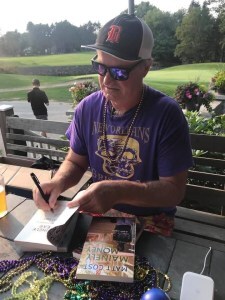
The natural artistry of Maine was aided by the Hardy Boys in my decision to become a writer at age eight. Along with Nancy Drew, Encyclopedia Brown, and the Great Brain. These early mysteries would be replaced for a time by the westerns of Louis L’Amour, which were little more than PI stories set in the west. The protagonist rides into town, becomes enmeshed in local wrongdoing, and fixes the situation. Think Jack Reacher.
But then I became a history major at Trinity College and one particular professor got me excited to write about the past. For the first time I realized that history was really the greatest story ever told. I decided to give a try at historical fiction and chose as my topic the charismatic Fidel Castro and the time of the Cuban Revolution of 1953-1959. I finished a first draft of this novel in 1990, my first year out of college, and immediately realized three things. I was a terrible writer, I needed to do more research, and I needed to visit Cuba to write more sincerely about that island nation.
In the meantime, I had to make a living, especially when the kids started popping up, so I opened a video store. And then a health club. And, perhaps the reason I’m now a blogger for Maine Crime Writers, a mystery bookshop, The Coffee Dog Bookstore. During those years, I wrote a couple of mysteries about a PI who also owned this very same business, as well the namesake Coffee Dog. The bones were good, but my craft still needed work.
In 2015 I wrote a historical about Joshua Chamberlain. I thought this was pretty good, but I was unable to find a publisher, so I self-published it. The following year, I got the opportunity visit Cuba and follow the revolutionary war trail of Fidel and his band of bearded guerrillas. This allowed me to return and rewrite that novel, originally written some twenty-five years earlier. And in March of 2021, Encircle Publications, published it, right at the start of a pandemic.
Between finishing that novel and the publication of it, I was attending various writing conferences, mostly historical in nature. I did not feel like I fit in. And then I attended Crime Wave in Portland and my life changed. I’d met my people. My tribe. This was confirmed by going to ThrillerFest in New York City and then Crime Bake outside of Boston.
Trapped at home along with most of the rest of the world, I got down to the brass tacks of writing. Every day, all day. I rewrote those early Mainely Mysteries, based in Brunswick, with a PI who also owned a mystery bookstore. The first one, Mainely Power, was recommended by Gerry Boyle and selected by the Maine Humanities Council as the Read ME fiction book of the year. The fourth one, Mainely Angst, is due out in January of 2022.
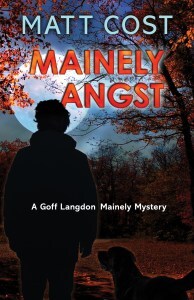
Looking for some variety, I began a new series as well, about a fictional coastal Maine town named Port Essex. Clay Wolfe is a former Boston homicide detective returned to his hometown. He sets out his PI shingle while taking care of his elderly grandpops. Wolfe Trap and Mind Trap have been published, while Mouse Trap and Cosmic Trap are due out next year.
I am still a lover of the past, though, so I penned a historical novel about the fight for social equality in New Orleans after the Civil War. Love in a Time of Hate also involves the hunt for a serial killer, Voodoo, politics, street fighting, and racial unrest. It is a powerful book that in many ways mirrors what is going on today in our country.

My latest work in progress, of which I just finished the first draft of on Thanksgiving day, blends my love of histories and mysteries. Eight Ballo is a PI in 1923 Brooklyn who is given the case of finding a missing young lady. This is also due out in 2022.
That is me. Not a true Mainer, but forty-six years toward that goal, with children who were indeed born here. I’ve owned local businesses, taught history at the junior high in Brunswick, and have coached just about every sport imaginable at one level or another. And now I write.
My website is: http://www.mattcost.net
Or contact me at: matthew-cost@comcast.net
November 29, 2021
How to Outline Using the 3-Act Structure
Today’s blogger got bogged down (I almost wrote “Blogged down”) so since we’re all about craft as well as all things Maine, we’re sharing a post about story structure from our blogging alum, Jen Blood:
Jen Blood: When I first started writing, I rarely had any idea how a story would end or what kind of twists and turns I might find over the course of the process. I liked it that way – it meant more surprises for me, and I loved going along with the characters on a journey that could ultimately take us anywhere. Eventually, I would invariably find my way and at some point I would get where I was going. During that process, there were usually a few false starts and sometimes I would figure out that the bad guy was someone I hadn’t even suspected initially, which would mean having to go back and retrace my steps, plant clues that might not have been there before, and make sure I hadn’t inadvertently written a solution to the mystery that would be disproven by some detail dropped earlier in the novel.
That worked just fine when I was working on a novel consistently for ten or twelve hours a day, six days a week. Back then, I lived in an apartment alone with two dogs and worked from home. My characters were my friends, I lived the story I was writing, and I was so immersed in a work-in-progress, it felt like I inhabited those words. Now, I live in a giant house with a dog and a cat and a man and sometimes that man’s seventeen-year-old child. There are gardens and shared meals and dog walks and doctor’s visits and so, so, so much vacuuming. I need a way to keep track of my novels, now that my writing isn’t exactly the central focus of my life. Which is where outlining comes in.
I’ve always outlined to some extent. A few years ago, however, I got very interested in three-act structure – one of the oldest, simplest, and best-known types of dramatic structure. To be clear, when I talk about three-act structure I’m talking about several specific components that make up a dramatic work. These are the basics, and I’ll just use a simple story about a round orange cat to illustrate what I mean.
Act I:

Inciting Incident – The event that sets the story in motion. Within the inciting incident, there is often the foreshadowing of the Obligatory Scene – the inevitable moment readers are waiting for, when the protagonist fulfills his destiny.
After a heated argument in which our protagonist’s virility is impugned after he’s compared with the neighbor’s conceited Russian blue, a round orange cat leaves his lady friend cat at home, and goes out seeking adventure. He spies a plump bluebird, and climbs a nearby oak to catch said bluebird.
Turning Point #1 – A complication shifts the story in an unexpected direction.
The bluebird flies away, and ROC (round orange cat) can’t get back down the tree.
Act II:
Midpoint – A dramatic event deepens the conflict for the protagonist and intensifies the readers’ suspense/ups the stake in the story.
ROC, still stuck in the tree, smells smoke and realizes a nearby house is on fire. The flames are getting closer.

All is Lost – Events seem to be conspiring against the protagonist; there is no apparent way out of the dilemma in which they have found themselves.
ROC tries once more to climb down the tree, but is paralyzed whenever he tries to venture from the branch he’s been perched on for an hour. Meanwhile, sparks from the nearby blaze are beginning to land close to the cat’s tree.
Dark Night of the Soul – With no apparent solution and all hope lost, the protagonist despairs. How will he solve the crime/rescue the girl/save the world?
Alone and terrified, certain that his lady love was right and he truly is worthless, ROC hunkers down and prepares for his demise.

Act III:
Final Commitment – Some internal or external force restores the protagonist’s faith in himself, and he is now determined to prevail.
ROC hears the cries of his lady friend cat, and realizes she is in dire need of saving.
Crisis – The sequence of events that sets the climactic scene(s) in motion.
Terrified but determined, ROC faces his fear and slowly, painfully makes his way back down the tree.
Climax – The moment everything has been building toward (frequently, the obligatory scene foreshadowed at the inciting incident, or a twist on it).
Down from the tree, ROC evades the flames, finds his feline love, and is about to save her when he realizes she’s trapped with the neighbor’s Russian blue. They’ve clearly been consorting for some time. Hurt but nevertheless heroic, ROC risks his life to save his feline damsel and her unsavory cohort.
Denouement – The final strands of the piece are pulled together and random bits are explained as needed.
On solid ground once more with the feline damsel enraptured by his heroic act, ROC turns his back on her and Russian blue and leaves with a pudgy tortoise shell named Sheila.

So, that’s three-act structure in a nutshell. When I first started using it, I would either apply the elements retroactively to a completed draft of my novel, or I would start using it halfway through the novel as a basic guide to figure out where I was going. I found it challenging, however, if I didn’t have a clear understanding of what the novel was about as a whole.
Then, I read an article on outlining that suggested coming up with the ending of a story first – before getting anything else down on the page. I’ve looked high and low to try and find that article, or who wrote it, or what else is in it, and I unfortunately can’t. The only thing I remember is the recommendation that an author try coming up with the ending first. I think I stopped reading at that point, because I wanted to try applying it to whatever novel I was working on at the time. I did, and the rest is history. For me, the pieces fell into place from there. This, then, is how I outline a novel in full before I begin writing.
I start with the ending. With all of this, keep in mind that there’s always room to play – no one says I have to stick with the outline. Characters still surprise me, and I’ll often find halfway through the novel that the ending I’ve written or the twists I’ve manufactured can be outdone by something else. But, I start everything with some ending.
From there, I go through and write an outline based on the three-act structure explained above. I get pretty detailed, and definitely think about the obligatory scene and any twists and turns that might come in along the way. When I first started, my final novel looked very little like the original outline… These days, however, I’m writing a bit faster and have a better sense of the way novels (and my characters) work, so what I first put on the page in the outline is close to what is ultimately published.
What I like best about this process is the fact that starting this way means I can generate a fairly extensive list of scenes revolving around the elements within the structure. If I’m not feeling particularly creative one day, all I need to do is go to the outline and go through the motions until my muse returns. Once that happens, things feel spontaneous and magical all over again – but since I can’t count on spontaneity and magic to earn a living as a writer, I know I’ve got the outline to fall back on whenever necessary.
If you’re interested, I’ve created this handy infograph with the key elements of 3-act structure here. Feel free to download and reference whenever you need it, and happy outlining!
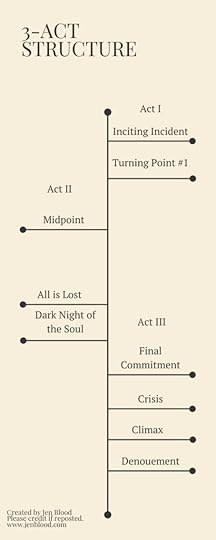
Jen Blood is the USA Today-bestselling author of the Erin Solomon Mysteries and the Flint K-9 Search and Rescue Mysteries. You can learn more at http://www.jenblood.com.
November 26, 2021
Weekend Update: November 27-28, 2021
 Next week at Maine Crime Writers there will be posts by Dick Cass (Monday) a guest blogger (Tuesday), Kaitlyn Dunnett/Kathy Lynn Emerson (Thursday) and Kate Flora (Friday).
Next week at Maine Crime Writers there will be posts by Dick Cass (Monday) a guest blogger (Tuesday), Kaitlyn Dunnett/Kathy Lynn Emerson (Thursday) and Kate Flora (Friday).
In the news department, here’s what’s happening with some of us who blog regularly at Maine Crime Writers:
An invitation to readers of this blog: Do you have news relating to Maine, crime, or Writing? We’d love to hear from you. Just comment below to share.
And a reminder: If your library, school, or organization is looking for a speaker, we are often available to talk about the writing process, research, where we get our ideas, and other mysteries of the business. We also do programs on Zoom. Contact Kate Flora
November 23, 2021
Over the River and Through the Woods – MCW Thanksgiving Memories
Today we’re sharing Thanksgiving stories, photos, possibly even some recipes. Hope you enjoy, and have a happy holiday.


Kate’s all-time favorite family Thanksgiving picture, our group walk after dinner. Don’t we look rustic?
John Clark: I must have taken this one because I’m invisible. Thanksgiving has many memories, some bad, most good. When I was young, it was a toss-up whether hunting or eating took priority. Eating generally won. Then as time went on, there were long cutthroat card games while we digested food in order to make room for more pie. I remember winning one pie eating contest in the 1990s that backfired because I couldn’t look at dessert for days. Thanksgiving now involves our daughters, their husbands and best of all three grandchildren, Piper, Reid and Gemma. I’m particularly thankful this year because Lisa, Sam and Gemma now live an hour away as opposed to Port Chester, NY, so everyone will be at their house this Thanksgiving.
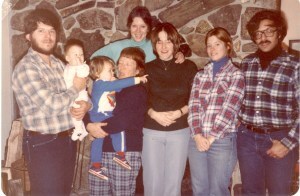
Another Thanksgiving at Sennebec Hill Farm
Kaitlyn Dunnett/Kathy Lynn Emerson: Thanksgiving always seems to revolve around food and family, back when I was the kid in the photo in 1950, and in 2003, when the family gathering first included our great niece, now a very grown up young lady of eighteen.
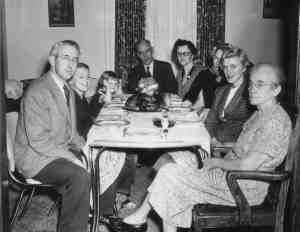
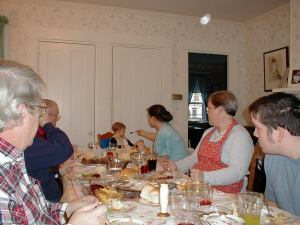
I’m looking forward to catching up on news and to stuffing myself on turkey, stuffing, rolls, apple pie, and that frequent addition to Maine holiday tables, the whoopie pie.
Maggie Robinson: 1979 was a most memorable Thanksgiving for the Robinson family. My husband was the new headmaster at Lee Academy, so we’d moved into Dewdrop Cottage, a house on campus.
The move from Virginia had been somewhat stressful that August, as I was six months pregnant with Baby #3, and had a 5-year-old and an almost 3-year-old. (Baby #4 would not come along until 1983, just in time for Easter.) But everything was finally in place for our first Thanksgiving in our new house. We had a smallish turkey, as only the only guest was my mother-in-law, who drove up from Brewer that morning and planned to drive back the next day. Oops.
All during dinner I felt uncomfortable, so we decided to go to my doctor on Friday to see what was cooking with the baby who was already over a week late. He put me in the hospital, but Jessie did not arrive until Saturday afternoon. My poor mother-in-law was stuck at in Lee with two little kids and no clothes for almost a week. When I came home with the baby, she shot out of the house like her pants were on fire. She’d had quite enough, LOL.
We always tease Jessie that she weighed more than our turkey that year. At 9 pounds 11 ounces, she was plump and juicy and looked just like a baby doll you’d buy in the store–blonde, blue-eyed, rosy-cheeked. She’ll be with us this year to celebrate her birthday with a gluten-free cake as well as pumpkin pie. 
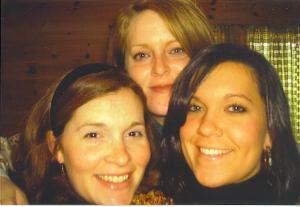
The Robinson girls
Kate Flora: I’ve always found it a bit strange that our traditions evolved so that Ken and I and the boys would spend Thanksgiving in Maine with my family and Christmas in Massachusetts with Ken’s family, who are Jewish. But that’s how it ended up, and so we would head north either the night before or the morning of, to the farm. Sometimes that Thanksgiving morning would be clear and brown, sometimes icy, sometimes snowing. There would steaming pots on the stove and the delicious smell of roasting turkey filling the house. There were traditions that couldn’t be changed–there had to be a tall glass compote filled with fresh fruit. There had to be trays of dates and figs. There had to be a hammered aluminum bowl of mixed nuts and a stack of lobster crackers doubling as nut crackers. While the grandchildren waited for dinner, they could crack nuts until the entire area around that bowl was a sea of bits of shell and crushed nuts.
When we were kids ourselves, our house was always the venue that relatives came to. The women would cook and the men would go out hunting, coming back somehow miraculously just as the turkey came out of the oven. I know I’ve told this story before, but I love the year that my feminist mother, sick of the women doing all the work while the men sat and waited to be fed, put slips of paper in a bowl with everyone’s name, and pairs were drawn out to take turns washing and drying the dishes. There was no dishwasher. My father was outraged at the sight of his elderly uncles washing dishes.
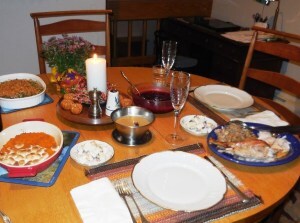
Cranberry sauce upper right beside the gravy boat.
Susan Vaughan: No matter whether my husband and I join other family members for the holiday, when we get home, we always have our own turkey with all the traditional accompaniments. One special dish is the cranberry sauce made from his mother’s recipe. I grew up being served the canned, jellied cranberry sauce, but always passed it on to the next relative. Some people prefer it, but my husband’s mom introduced me to her whole-berry sauce and the recipe. The amounts are easily reduced or expanded. Here you go: Mrs. Vaughan’s Cranberry Sauce. 1 12-ounce package of whole cranberries, 1 1/2 cups of water, 1 1/2 cups of sugar. Put all together in a saucepan on the stove. Stir until the sugar is dissolved. Bring to a boil and boil for 20 minutes. Let cool a bit. Then pour into a bowl or a mold and chill. It’s the best!
Maureen Milliken: Thanksgiving has always been my favorite holiday because, let’s face it: food, food and more food. I like the basics. Turkey, stuffing, mashed potatoes, gravy and cranberry sauce. The leftovers are as good as the originals. I could eat it for weeks. For many years, working for newspapers, I’d work on Thanksgiving, but frequently would try to find a local restaurant serving a traditional Thanksgiving meal, or make my own. I don’t care who cooks it, as long as it is there.
I’m not a fan of Thanksgiving Day football on TV, mostly because no one in my family has a large enough house to separate the loud football-watching from the conversation with family. My point is, why are we all getting together if we’re going to watch football rather than socialize? And I prefer buffet-style service to sitting around a table. Please don’t get in between me and the food.

A recent Thanksgiving at my sister Nicki’s in New Hampshire with, from left, my mom, my niece Adele, Nicki, my sister Becky and my sister-in-law Nina. Where are the menfolk? The screen with the football game in the background may give you a hint.
I did host one Thanksgiving for the entire family, in 1999. I’d bought my first house, in Manchester, New Hampshire, a few years before and was anxious to actually use the dining room. I remember it as being a resounding success, and also the only Thanksgiving, I believe, that we have a full family photo from.
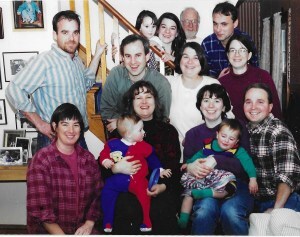
Thanksgiving 1999, the only time I hosted the entire family. Some of those babies have babies of their own now.
Over the years, Thanksgiving dinners that included my five siblings and their families have pretty much fallen by the wayside — people are far-flung and the crowd is too big. For several years, my parents alternated between having it at their house in Portland and going to my youngest sister’s in New Hampshire, but in more recent years, they’ve preferred to stay home in Portland , and we usual gather with my two siblings who live there, one of whom lives with them and one who lives a few blocks away, any other related hangers-on.
I start focusing in late October on making sure someone at my parents’ house will be providing Thanksgiving dinner. This year I was given a free turkey from one of my freelance gigs, which made things easier. I also always bring the cranberry sauce. There was a time in my life when I atually thought it always was a round oblong, with the imprint from a can on it. When I discovered that it could be a delicious lumpy so tart and so sweet homemade treat (or bought from a local maker), I was so totally on board. There is nothing — nothing! — as scrumptious as a forkful of turkey, cranberry sauce, mashed potatoes, stuffing and gravy all in the same mouthful. Side note: In our teenage and early adult years, my siblings and I called cranberry sauce “I buried Paul.” Beatle fans will remember that on “Strawberry Fields Forever,” John Lennon, with a little imagination, can be heard saying “I buried Paul.” Lennon said what he was actually saying was “cranberry sauce.” And why wouldn’t he be?
Another family tradition is someone calling out, “How can these rolls be burned on the outside and still frozen on the inside?” Another treasured ha ha holiday memory from the past. But a story for another day.
Here’s how I make cranberry sauce (I can’t claim it as an original recipe, I’m sure many folks make it the same way). This makes a good enough batch for a small Thanksgiving dinner with cranberry-sauce lovers, but can easily be expanded to make more. It takes about half an hour to make and is best made the day before, if not even more in advance, so it’s nice and chilled and jelly-like:
INGREDIENTS
1 cup of sugar
1/2 cup of water
1/2 cup of orange juice
4 cups cranberries (either frozen or fresh, if fresh be sure all stems are removed and cranberries are rinsed)
Boil water, orange juice and sugar in a medium or large saucepan until all the sugar is dissolved.
Add cranberries. Once it starts boiling again, lower heat to simmer and let it cook about 10 minutes until most of the cranberries have burst, then turn off the heat.
Let cranberry sauce cool and thicken in the pot until it’s room temperature, then put it in a bowl or container and put it in the refrigerator.
If you like it with add-ins — nuts, cinnamon, orange rind, etc. — but them in after you’ve removed it from the burner but while it’s still hot and before it starts to thicken.
Brenda Buchanan: Great cranberry sauce recipe, Mo!
I can’t claim my story as a memory but it’s true, and it’s not exactly a Thanksgiving memory but close.
I was born on the first of December, which in the year of my birth was during hunting season in Massachusetts. My father was not a dedicated hunter, but he enjoyed a quiet walk in the woods. That year some friends invited him to go hunting on the first of December, so on the night of November 30 he prepared to head out early the next morning for the first time all fall.
During the evening he set his hunting license on the kitchen table and set about gathering the rest of his gear. He awoke at 5 a.m., dressed in darkness and crept downstairs. He shrugged on his coat and reached for his hunting license, but his fingers didn’t find it. When he switched on the light, it was nowhere to be found.
As the story was told every year, Pa called his friends after turning the kitchen upside down to report he couldn’t join them after all, because he couldn’t find his darned hunting license. He returned to bed, only to be awoken a couple of hours later when my mother went into labor. Had he been off hunting she would have had to call an ambulance to get to the hospital, but thanks to the missing license, he was right there with her for the birth of the second Buchanan daughter.
Later somebody found the missing license in a most illogical place. Apparently, my sister SuEllen, 15 months old at the time, was going through a stage where she found it hilarious to toss things into the trash. There it was, among the family detritus, and everyone agreed she’d saved the day.
November 21, 2021
Apply the Bechdel Test, with a twist, when you read, watch and write
I recently learned about the Bechdel Test for sexism in fiction. This is a way to gauge the level of sexism in a work by checking to see if it has a conversation between two women that isn’t about a man or men. It’s been on my mind for a week or so, ever since I watched the documentary “This Changes Everything,” which is about how tough it is for women in Hollywood to get jobs as directors or other male-traditional jobs, or even get good parts.
At first I thought, gee, it can’t be that rare to have two women in a movie, TV show or book talking about something other than men. Then I started paying attention. In the past week or so as I’ve watched many episodes of a well-loved ’90s sitcom, several episodes of two different BBC shows based on very popular books (both by women), a few episodes of other British and U.S. mystery series and two movies, I’ve found not only is it rare to have two women having a conversation about something other than men, it’s rare to find two women having a conversation about anything.
This eye-opener came as I was already getting irritated at the number of mystery and crime TV shows and movies I’d seen recently that had plots that involved either strip clubs or sex workers. If an alien landed on Earth and got all their knowledge about our culture from TV crime shows and movies, their conclusion would be that the best job opportunities for women are in sex work, and that many, many women spend most of their time wearing nearly nothing in order to show off their young very attractive perfect bodies. If a show or movie has a fair amount of women in it, often it’s because the show has a strip club or hooker theme.
I know many of you right now are thinking of all the exceptions to what you’ve just read. That’s great. There are exceptions. Thank goodness! But wouldn’t it be great if the exceptions were the norm?
If you want a dose of reality, here’s a Bechdel Test with a Milliken twist. (And as an aside, similar testing can be done for race, but today I’m talking about women). I’ve devised a series of questions not only to ask when I’m watching and reading, but also to ask when I’m writing. All these scenarios, if the gender were flipped, are fairly normal for male characters. Not so much for women, I’ve discovered:
A conversation — about anything — between two women
A conversation — about anything — between two named female characters
A conversation — about anything — between two women who are significant characters in the book, TV show or movie
A conversation between two women that isn’t about a man or men
A conversation between two women that’s doesn’t involve a female cop interviewing a female suspect or witness
A conversation between two women in which one later doesn’t end up being a victim (therefore the conversation is mostly an introduction set-up)
A major positive (or likable) female character who is overweight/middle-aged/considered in some way to be conventionally unattractive
A major positive (or likable) female character who is overweight/middle-aged/considered in some way to be conventionally unattractive who has a real love interest who doesn’t later turn out to be a murderer, con man etc.
Female characters central to the plot who aren’t strippers or hookers
A professional group (cops, work/professional group central to the story that’s not a group of strippers or hookers, friends group, etc.) with more than one woman or where women have representation that reflects real life
A girlfriend/wife/love interest for a male protagonist who’s his age or older (and if she is his age or older, it’s a good, strong relationship)
A strong female character who doesn’t become the love interest of the male protagonist
A strong female character who doesn’t become a victim
I’m sure that I’ll get emails from people insisting I’m overreacting, wrong, laden with examples that “prove me wrong.” Or with rationalizions as to why female characters can’t be used in stronger, better ways. Fighting it, instead of taking a deep look at it, won’t solve the problem, though. As I’ve said, I’m putting the test to my own writing going forward. My books don’t have strip clubs or sex workers — there are way too many good professions and interesting crimes for women that don’t involve further objectifying us — but on some of the other questions, I have room for improvement.
I’ve been waiting for six decades for the world to change, and in a lot of ways it has. But, in a lot of ways it hasn’t. Changing the world of fiction is a step in the right direction.
November 19, 2021
Weekend Update: November 20-21, 2021
 Next week at Maine Crime Writers there will be a post by Maureen Milliken on Monday and an alumni post on Friday. On Tuesday we’ll be sharing Thanksgiving stories and on Thanksgiving we’ll be taking the day off.
Next week at Maine Crime Writers there will be a post by Maureen Milliken on Monday and an alumni post on Friday. On Tuesday we’ll be sharing Thanksgiving stories and on Thanksgiving we’ll be taking the day off.
In the news department, here’s what’s happening with some of us who blog regularly at Maine Crime Writers:
John Clark is happy to announce that he has three stories in the 2021 BOULD Anthology just released this week. They are “Bait and Switch” and “Bust My Buttons.”

An invitation to readers of this blog: Do you have news relating to Maine, Crime, or Writing? We’d love to hear from you. Just comment below to share.
And a reminder: If your library, school, or organization is looking for a speaker, we are often available to talk about the writing process, research, where we get our ideas, and other mysteries of the business. We also do programs on Zoom. Contact Kate Flora
November 18, 2021
Remembrance
Kaitlyn Dunnett/Kathy Lynn Emerson here, once again waxing nostalgic. The farm that belonged to my mother’s side of the family has appeared in many of my books, in one guise or another, and I even based my children’s book, Katie’s Way, on Mom’s recollections of growing up there in the 1920s, but until now I haven’t singled out the one person who made time spent at the farm most memorable.
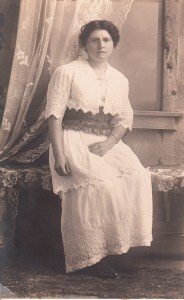
Catherine May Hornbeck was born on January 18, 1886 in Hurleyville, New York, the second child of Myron (known as Miles) Hornbeck. He inherited the family farm from his father, Lawrence. I imagine it was shortly after he married Ella Applebee, whose family ran a small hotel, that they expanded into the business of taking in summer boarders. Farm/boardinghouses were common in the Sullivan County Catskills. Folks from New York City flocked to the area in search of fresh air and cooler temperatures.
Catherine, known as Katie (although not the Katie in my novel) had four younger siblings, two sisters and two brothers. It was Tressa, three years younger, who was actually my grandmother, but since she died giving birth to my mother in 1910, I never knew her. It was Katie, along with her parents, who raised the baby, Marie, since Marie’s father worked for the O&W Railroad and was away much of the time. He lived at the farm when he was home, but he may not have felt all that welcome. His mother-in-law, Ella, blamed him for Tressa’s death. She may have had some cause. In doing genealogical research, I discovered that Leslie Hamilton Coburg and Tressa Estelle Hornbeck married only a few months before my mother was born.
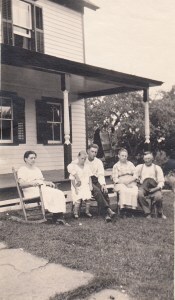
1915: Katie, Marie, Les, Ella, and Miles
Somewhere along the line. Katie fell in love with her sister’s widower, but her mother forbade them to marry. It wasn’t until after Ella died that they could finally wed. For me, Katie was Grandma Coburg.
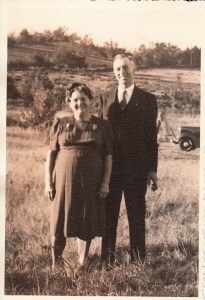
Tressa was a portrait on the wall of the living room at the farm.
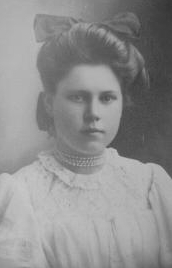
I have many fond memories of Katie Coburg. She sewed and crocheted and hooked rugs. She regularly listened in on neighbors’ telephone conversations on the party line. She raised chickens for their eggs and we had Sunday dinner at the farm (chicken, of course) every week. I often stayed there during the week, too. By that time the boarders were roomers, cooking their own meals in kitchenettes off the summer dining room. Years later, I learned I wasn’t the only one who loved visiting the farm because of Katie. Some of my Hornbeck cousins did, too. And so did the daughter of my mother’s childhood neighbor and lifelong friend.
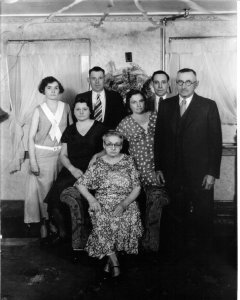
The Hornbeck siblings at their parents’ 50th anniversary
After all the others married, Katie was the only sibling still living at the farm. Her father left the property jointly to all five of his surviving children, but he left the furniture to Katie. I always knew she loved the farm and never wanted to leave it. What I didn’t know until much later was that her siblings would have preferred to sell it. I was eight or nine when she and my grandfather briefly looked at houses in the town where I lived with my parents. She was in tears at the thought of uprooting herself from the only home she’d ever known.
The older I get, the more I understand clinging to the familiar. I’ve traveled to many parts of the U.S. and visited several other countries, but I get it—home is where the heart is. Katie never wanted to leave. In the end, she didn’t have to.
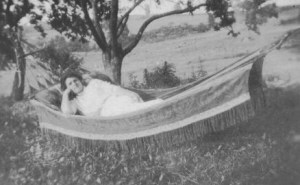
I was ten when she died. After the funeral, held at the farm, Mom had me ask Grampa to come live with us. I didn’t understand then that the farm was about to be sold and he had no place else to go. I still don’t know all the details surrounding the sale. I do know there were hard feelings, and that I never saw most of my Hornbeck relatives again. A few years later, the farmhouse burned to the ground.
No place has ever had such an impact on me, and few people have ever held such an important place in my memory. As Thanksgiving approaches, I’m thankful to have had Grandma Coburg in my life.
Kathy Lynn Emerson/Kaitlyn Dunnett has had sixty-four books traditionally published and has self published eight more, including several children’s books. She won the Agatha Award and was an Anthony and Macavity finalist for best mystery nonfiction of 2008 for How to Write Killer Historical Mysteries and was an Agatha Award finalist in 2015 in the best mystery short story category. She was the Malice Domestic Guest of Honor in 2014. Her most recent publications are The Valentine Veilleux Mysteries (a collection of three short stories and a novella, written as Kaitlyn) and I Kill People for a Living: A Collection of Essays by a Writer of Cozy Mysteries (written as Kathy). She maintains websites at www.KaitlynDunnett.com and www.KathyLynnEmerson.com. A third, at A Who’s Who of Tudor Women, is the gateway to over 2300 mini-biographies of sixteenth-century Englishwomen.
Lea Wait's Blog
- Lea Wait's profile
- 506 followers


